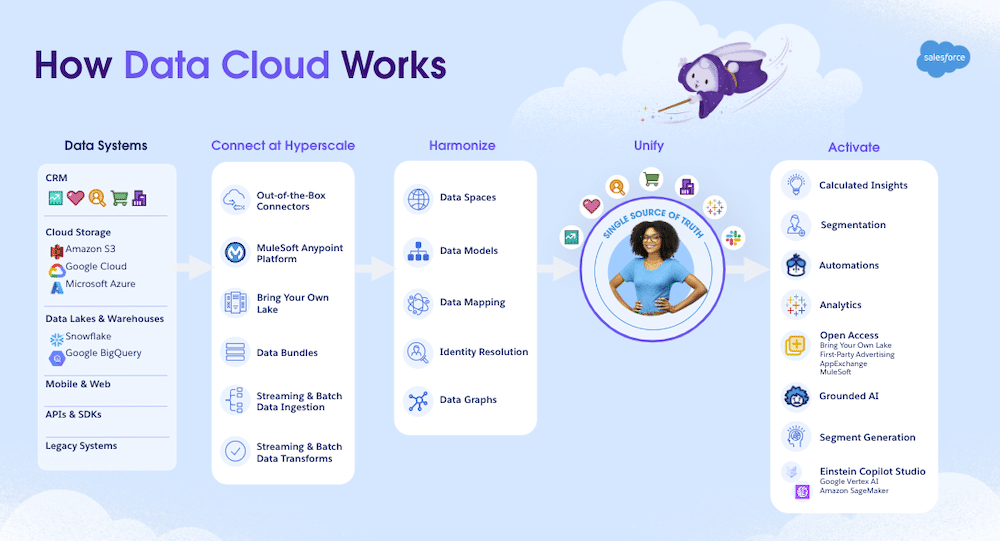Table of Contents
01
of 05
What is Data Cloud?
Data Cloud is an open platform that allows you to integrate, harmonise and unify data from diverse sources by leveraging a wide library of connectors that is native to Data Cloud in partnership with Mulesoft.
The Data Cloud journey consists of 5 phases:
Connect
In this phase, connections (Data Streams) are created, this is where Data Cloud draws data from scattered systems. Connections can be split into two groups: First-Party connections or Third-Party Connections.
Harmonize
Once collected, the Data is mapped from Data Streams into Data Lake Objects.
Unify
Identity Resolutions are used to match and resolve conflicts. This process will create a Data Cloud Model (Customer 360 Data Model) that can act as a single source of truth.
Analyse
With the transformed Data you are now able to: create predictions models using Einstein Studio, query your model with either the query editor or query it using the Calculated insights and Segment the unified profile based on your audience.
Act
This phase is where you generate real-time data streaming insights, analytics models using Tableau and CRM Analytics, AI-generated insights (Salesforce Einstein), triggered automation and where activations are enabled.

02
of 05
Considerations for Data Cloud
Define your Use Cases
The first thing you should do when considering using Data Cloud is to ask yourself, do I really need Data Cloud?
Do I have vast amounts of Data scattered across platforms that should be unified?
If so, you will need to outline a strategy with Use Cases from finish to start. Do this by picturing your desired outcomes from Data Cloud, the most frequent use cases include automating business processes based on customer data, providing a specific set of information in a specific context, gaining insights, consolidating data, and establishing a Data Governance model.
Establish Key Metrics and get align with the Customer 360 Data Model
Knowing your desired outcome will allow you to define the metrics that you will need and how they will be generated in Data Cloud.
These metrics can either come from the Customer 360 Data Model, segmentation, the query editor, Calculated insights, or predictions models with Einstein Studio.
The best practice would be to understand if the metric that we want can be generated by the Customer 360 Data Model.
Design your Data Strategy
Having now a plan on how to calculate your metrics, you should think on how to manage your Data, know where the Data that comes from, list every connection that you will need to make, including every org and integration that you require to get to your use case.
Try to keep these at a minimum, so you don’t have unnecessary Data lying around, keep in mind that Data cloud does not provide a magical fix for your Data so if the Source Data is not providing the necessary information for Data cloud to combine it to other Sources there will be no match.
You should define your Data governance strategy, so the place where your Data is mostly correct, should overrule other Sources that have a close match.
Unified Profile vs Records
A Unified Profile will not replace your user records; it acts as an extra layer between the user and the record. So, if incorrect Data on your record is corrected within Data Cloud and comes back correct in the unified profile, it will still be incorrect in the underlying data. If two records are ‘replaced’ by the same unified profile, they will still exist separately.
So, if you want to address these common misconceptions, you can combine Data Cloud activations with Salesforce flows. This is not a direct step, it needs to be configured to better fit your solution.
Not available in Sandboxes
Data Cloud is not available in Sandboxes, which means that the teams working with this tool need to be extra careful with its development. Every development test will consume credits.
Difference between Data Actions and Activations
- Activations consist of sending segmentations back to other systems, Clouds or Data Warehouses.
- Data Actions consist of triggering actions such as Salesforce Platform Events( flows, Apex…) , Webhooks and Marketing Cloud actions.
Activation Limitations
Activations are not available in the free edition of Data Cloud, so if your use cases include Activations, and they most certainly do, the free version will not be enough.
Real-time Data
By leveraging the Salesforce Ecosystem, Data Cloud provides real-time data processing and insights, empowering users to make informed decisions, enhance user experiences, and optimize automation, ultimately reducing data silos.
Use a Data Warehouse
Data Cloud is a Salesforce Product focused on connecting Data from diversified sources and combining them as required. It is crucial to keep this in mind since credits are spent to execute features and available cloud space will be consumed. Considering this you should not plan to use Data Cloud as a Data Storage, it will cost you significantly more resources.
Connect to multiple Orgs
Data Cloud is able to connect to multiple clouds in your org however Data Cloud One can connect you to multiple orgs.
Data Cloud can be added to an existing org, functioning as a system of record, or it can function separately as a system of reference.
Credits and ROI (Return on Investment)
Investments are successful when they yield a return, so before making any decision, it is crucial to address the estimated cost of the implementation based on credits. Since every operation involving Data will consume credits, this assessment should consider the use cases to be developed and the most suitable licenses from the current pricings, against data load, the work hours it takes to fully sync the Data across systems, the number of times the request is asked, and the employee allocation.
03
of 05
Data Cloud Benefits
Data Cloud benefits, consist of but not only:
- As previously mentioned, Data Cloud consolidates dispersed data into a 360 user view.
- Applies complex integration logic by managing Data Streams from several platforms and using data consideration to ensure data quality and governance.
- Aggregating data which allows the business to understand the customer’s full lifecycle across multiple accounts and devices (Data Activation)
- It provides a user-friendly interface build on lightning
- Real-time data, insights and synchronization
- Triggered based automation (Data Actions)
- Building the foundations to use Agentforce
Data Cloud downsides rely mostly on:
- The dependency of data consistency and integrity
- Complexity of implementation and customization limitations
- Consumption of credits during the implementation
- Possibility of performance issues due to Data overload
- Integration challenges
- Requiring ongoing maintenance and having frequent updates
- Increase in costs
04
of 05
Who should use Data Cloud?
Businesses of all sizes that have large Data Volumes and use cases should use Data Cloud. The 360-degree user model can provide powerful insights, even in small businesses, as long as the ROI is justified.
Considering a Sales Cloud platform, that focuses on consumer sales, Data Cloud can unlock a big stream of Sales by relating previous interactions of the costumer with the current one and providing for instance the likelihood of the purchase to happen, the frequency of this purchases, relate them to other customer behaviour, relate them to other products and brand.
A larger business might have multiple instances and might want to relate Marketing Cloud data to Sales Data and focus its marketing strategy to each individual providing a more personalized business experience. Data cloud is able to do this by using segregation into brands, regions or Departments.
The requirements
In order to use Data Cloud in its full extent you will need to have a Salesforce org in your organization, activate Data Cloud, provide the necessary permissions to the users that will be implementing Data Cloud features.
05
of 05
Reach out to Stellaxius
Reach out to Stellaxius to have a better understanding on how Data Cloud can empower your Business and meet your needs. Contact us today!
SUBSCRIBE KNOWLEDGE CENTER
Subscribe for free to our Knowledge Center to get the latest articles straight to your inbox!







